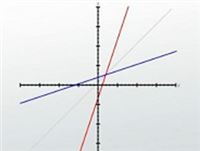
Examples
Following these steps, let's say we have a function f(x)= 3(x - 1) + 2.
We're going to write this out in terms of x and y: y = 3(x - 1) + 2. Then we're going swap the x and yvariables, so we're going to write this as x = 3(y - 1) + 2. This can be a confusing step if you're not careful, but at its heart, all you're doing is putting xeverywhere you see y and putting y everywhere you see x. Then you're going to solve for y as a function of x. So I'm going to subtract 2 from both sides, x - 2 = 3(y - 1), divide both sides by 3, (x - 2) / 3 = y - 1 and add 1 to both sides and I end up with y = 1 + (x - 2)/3.
I'm going to call what's on the right-hand side my inverse function, f-1 (x) = 1 + (x-2)/3. Finally, I'm going to check my answer, so I'm going to find f-1 of (f(x)). To do this, I'm going to write f(x) = 3(x-1) + 2. I'm going to plug that in as input for my inverse function, so f-1 (x) = 1 + ((3(x-1) + 2) - 2)/3. I have my input here, so I'm just going to solve and simplify for f-1 (x) = 1 + (3(x-1))/3: f-1 (x) = 1 + x - 1. And sure enough, f-1 (f(x)) = x, which is exactly what we'd expect.
So what about a function like y = round(x)? Remember that round(x) just rounds our input to the nearest integer: round(4.2) = 4. However, round(4.8) = 5 and round(5.1) = 5. In this case, do you think that you can find an inverse function that can take 5 and give your either 5.1 or 4.8? No, round(x) is a function that has no inverse.
Graphing Inverse Functions
What about the function f(x) = x3 + 3x? I can write it out in terms of x and y: y = x3 + 3x. I can then swap the variables, x = y3 + 3y. I can then solve it for y - but that's not immediately obvious to me. Is there another way? Let's go back and look at an easier function, like f(x) = 3x - 6. I end up with a graph that looks like this, a simple line. Now I'm going to graph the inverse, which is f-1 (x) = (x + 6)/3. So the inverse is this blue line; it looks a lot like the original function, except it's mirrored. And it's actually mirrored over the 45-degree angle, which is the x=y line. If I could fold this paper in half, then I'd see that the function and its inverse become the same line. I can use this on much more complex functions too. Say I was looking at a function like this. If I draw the 45-degree line and mirror it, then I can get a pretty good idea of what that inverse function looks like.